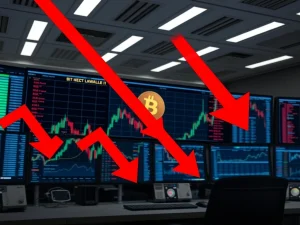Bitcoin’s Critical Juncture: Power Law Resistance Threatens $122,000 Breakthrough

The cryptocurrency world is buzzing as the Bitcoin price approaches a pivotal moment. With analysts highlighting a critical technical threshold, many eyes are now on the potential impact of the Power Law resistance model on Bitcoin’s long-term trajectory. Is the king of crypto about to smash through a major barrier, or are we witnessing a structural ceiling that will dictate its next move?
Understanding the Power Law: A Key to BTC Analysis
For many investors, the term ‘Power Law’ might sound complex, but its implications for BTC analysis are profoundly simple: it identifies long-term support and resistance levels with remarkable accuracy. The BTC Long-Term Power Law is a lesser-known but increasingly influential analytical tool that applies logarithmic scaling to both price and time. This model has historically pinpointed key levels, guiding traders and investors through Bitcoin’s volatile journey.
- Historical Accuracy: According to Alphractal, a prominent crypto analytics firm, the Power Law model has a track record of identifying significant turning points in Bitcoin’s price history.
- Logarithmic Scaling: Unlike linear charts, the Power Law uses logarithmic scales, which better represent the exponential growth and decay patterns often seen in asset prices like Bitcoin.
- Structural Insights: It helps to reveal underlying structural features of the market, which are shaped by cumulative market participation and network effects, rather than just short-term sentiment.
The $122,000 Structural Ceiling: Why It Matters
Currently, the structural ceiling identified by the Power Law model stands at a formidable $122,000. This isn’t just a random number; it represents a significant barrier that Bitcoin has yet to conclusively breach on this long-term chart. For traders and investors, this level is a focal point for several reasons:
- Confirmation of Bullish Trend: A decisive break above $122,000 would be a strong signal, required to confirm a sustained bullish trend and potentially propel Bitcoin into new all-time highs.
- Risk of Retest: Conversely, a failure to maintain gains or a rejection at this level could trigger a retest of lower support zones. The model’s creator, Joao_wedson, even suggests a potential retest as low as $108,000 by 2033 if the ceiling holds firm over the long term.
- Systemic Resistance: Analysts argue that this resistance is systemic, reflecting the fractal nature of price movements over extended periods. It’s a testament to the market’s collective memory and inherent patterns.
Navigating Current Market Dynamics: What’s the Bitcoin Price Doing?
As of late, the Bitcoin price has been consolidating near $118,560, reflecting the tension between short-term volatility and long-term adoption trends. This consolidation phase is a crucial period, as market participants assess whether the asset will sustain a breakout or retreat into lower ranges. On-chain data and various technical indicators paint a complex picture, making predictions challenging for both institutional and retail investors.
The market is currently a battleground of forces:
- Bullish Indicators: Despite the looming resistance, some technical indicators remain overwhelmingly positive. The recent BTC Monthly Candle breakout, for instance, suggests underlying strength.
- Subdued Sentiment: Curiously, the Crypto Bull & Bear Indicator (CBBI) remains relatively subdued. Analyst Colin Talks Crypto has pointed out that low retail enthusiasm and underheated sentiment indicators often precede euphoric market highs, suggesting a potential market top could arrive within six months.
This interplay means that while the technical setup looks promising for a potential breakout, the broader sentiment and participation levels are key wildcards that could influence the outcome.
Implications for Your Portfolio: Actionable Insights for the Crypto Market
The implications of this structural ceiling for market positioning are significant for anyone involved in the crypto market. Long-term holders and institutional investors, in particular, must carefully weigh the risks of encountering this structural resistance against the potential for renewed bullish momentum. Understanding the Power Law model provides a framework for making informed decisions.
Here’s what investors should consider:
- Caution is Key: While optimism for Bitcoin’s future remains high, the Power Law analysis suggests a high-probability scenario where resistance mechanisms may dominate in the near term. This calls for a balanced approach, combining optimism with a healthy dose of caution.
- Volume as a Validator: Volume dynamics will be a key determinant in the coming weeks. A surge in buying pressure, supported by robust volume spikes, could validate the $122,000 level as a temporary peak before higher highs. Conversely, a lack of sustained momentum may reinforce the Power Law’s prediction, triggering a retest of support below $111,000.
- Long-Term vs. Short-Term: For long-term holders, a temporary rejection might present a buying opportunity. For short-term traders, the $122,000 level is a clear pivot point for setting strategies.
The convergence of technical analysis, macroeconomic factors, and on-chain metrics creates a multi-layered framework for assessing the likelihood of a sustained breakout. This isn’t just about price; it’s about the very structure of Bitcoin’s market evolution.
The Road Ahead: What’s Next for Bitcoin?
The Power Law analysis doesn’t offer a definitive price forecast but identifies a critical juncture where resistance mechanisms are likely to be dominant. This aligns with broader financial theories on power-law distributions, which often govern extreme events and asset returns across various markets.
As Bitcoin approaches this critical juncture, the outcome of this standoff will likely influence broader adoption dynamics and institutional positioning in the months ahead. Investors should remain vigilant, monitoring not only the price action but also the underlying volume and sentiment indicators. The ability of Bitcoin to either decisively break or respect this long-term structural ceiling will be a defining moment for its trajectory.
In summary, the Power Law analysis provides a nuanced perspective on Bitcoin’s current price environment, underscoring the interplay between historical patterns and evolving market fundamentals. As the cryptocurrency approaches a critical juncture, investors must balance optimism with caution, recognizing that structural resistance could reshape its trajectory in the near term. The outcome of this standoff will likely influence broader adoption dynamics and institutional positioning in the months ahead.
Frequently Asked Questions (FAQs)
What is the Bitcoin Long-Term Power Law?
The Bitcoin Long-Term Power Law is an analytical model that uses logarithmic scaling on both price and time to identify significant long-term support and resistance levels for Bitcoin. It helps to reveal the underlying structural behavior of Bitcoin’s price movements over extended periods.
Why is $122,000 a critical level for Bitcoin?
According to the Power Law model, $122,000 acts as a structural ceiling. A decisive break above this level would confirm a sustained bullish trend, while a failure to do so could lead to a retest of lower support zones, reflecting systemic resistance derived from cumulative market participation and network effects.
How accurate has the Power Law model been historically?
Crypto analytics firms like Alphractal suggest that the Power Law model has historically identified key support and resistance levels for Bitcoin with notable accuracy, making it a valuable tool for long-term price analysis.
What does current market sentiment indicate for Bitcoin?
While some technical indicators for Bitcoin remain positive, sentiment metrics, such as the Crypto Bull & Bear Indicator (CBBI), are relatively subdued. Some analysts suggest that low retail enthusiasm often precedes euphoric market highs, hinting at a potential market top within six months.
What should investors do as Bitcoin approaches this resistance?
Investors should exercise caution and monitor volume dynamics closely. A surge in buying pressure with robust volume could validate a breakout. Conversely, a lack of momentum might reinforce the Power Law’s prediction of structural resistance. Balancing optimism with prudence is key.
Does the Power Law model predict an exact Bitcoin price?
No, the Power Law analysis does not offer a definitive price forecast. Instead, it identifies high-probability scenarios where resistance mechanisms may dominate, providing a framework for understanding potential price behavior based on historical patterns and structural market dynamics.








